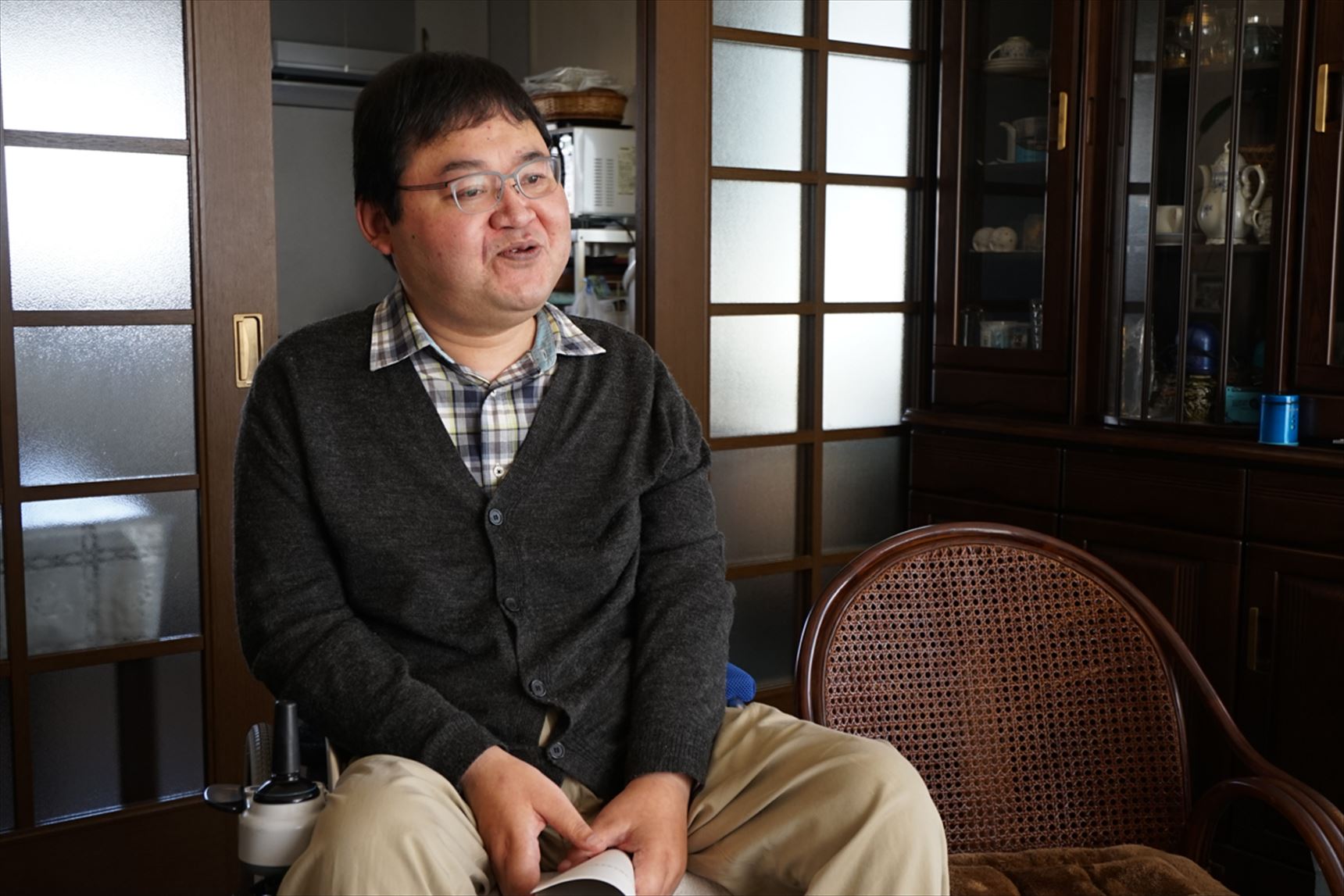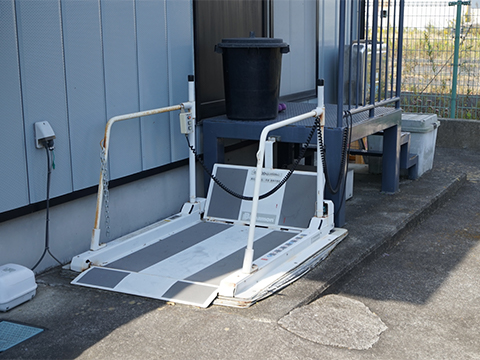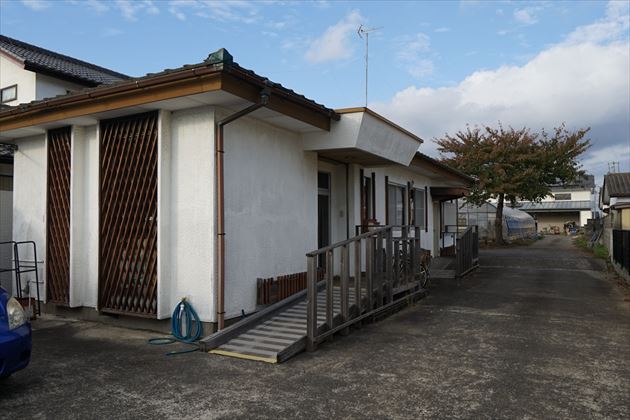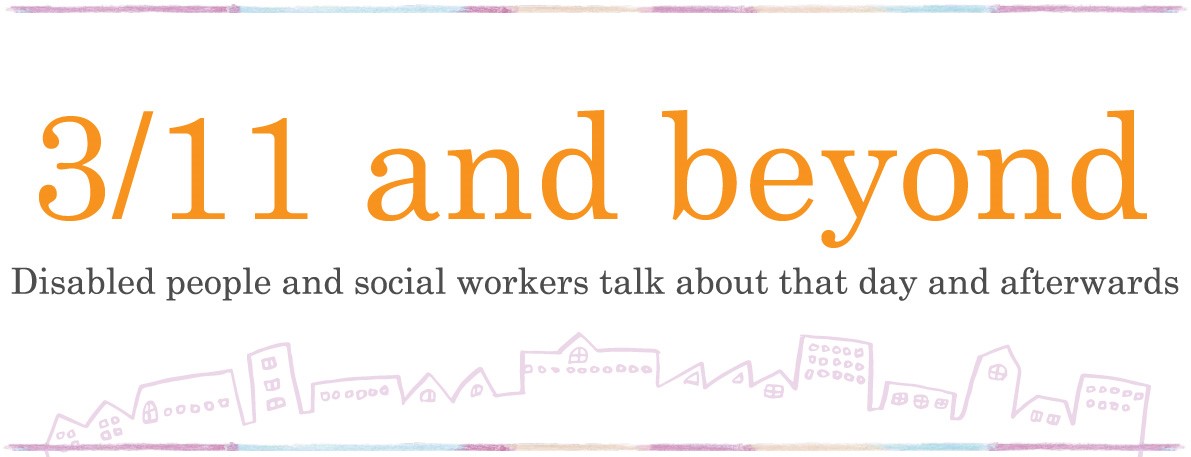 Story: Mr. Yoshichika Tobikawa (Male Man/ in his 40s at the time of the disaster/ SMA [spinal muscular atrophy])
Story: Mr. Yoshichika Tobikawa (Male Man/ in his 40s at the time of the disaster/ SMA [spinal muscular atrophy])Mr. Yoshichika Tobikawa
 Story: Mr. Yoshichika Tobikawa (Male Man/ in his 40s at the time of the disaster/ SMA [spinal muscular atrophy])
Story: Mr. Yoshichika Tobikawa (Male Man/ in his 40s at the time of the disaster/ SMA [spinal muscular atrophy])The moment of the earthquake
Have you had your leg problem since you were small?
Yes, since I was small. It started when I was around one year old, and it was diagnosed when I was in the second grade of elementary school. The disease is called spinal muscular atrophy or SMA. It’s characterized by progressive muscle wasting, and it is categorized as an intractable disease by the government. I could walk until I was about 20 years old. However, I fell and got injured in one occasion, and so walking was considered too risky. I started using a wheelchair and that made me unable to stand up on my feet.
I see. Where were you, and what were you doing on March 11th?
I was in a daycare center. It was a place where persons with disabilities from Ishinomaki, Yamoto, and Higashi Matsushima came for their service. It took about five minutes by car from my house. The center was in Akai district of Higashi Matsushima city, and was located next to the Miyagi Toubu Cardiovascular Hospital.
Tsunami was about one meter high. As it was a daycare facility, its building was barrier-free and the floors were as low as the street level. The service usually finishes at around 15 o’clock, but on that day, people were playing table tennis volleyball. I couldn’t play on that day and was feeling relaxed. I was dozing away thinking I could go home soon. Then suddenly all the mobile phones started to buzz and the tremor came. There was a home for the elderly near the Ishinomaki Nishi High School, and we were to move there for safety. While staff was preparing cars, someone outside said that tsunami was coming. Director of the daycare center ran to the cardiovascular hospital to see if they would accept us there. We all moved to the hospital then, 30 or 40 of us. Even before we moved, the parking lot of the hospital was immersed in water by the tsunami. Streets were flooded by waves. Staff members took the user of the daycare center one by one to the hospital. The hospital building was built on slightly elevated ground and all the wheelchairs were brought there. People who could walk walked to the hospital.
Did people carried wheelchairs?
Yes. Three or four people carried a wheelchair above water level at a time with person on it.
How deep was the tsunami at that time?
It was just like the depth of staff members’ shoes. We could have moved with wheelchairs if there was not more water coming in, but the water was getting deeper.
Do you remember what the time was?
The tsunami came rather late in Ishinomaki area. Joh River along the Route 45 burst and the water came from there. It was just after 15 o’clock I guess.
Meanwhile the staff was discussing where to take refuge, right?
We didn’t have much time. There was not much information source neither.
Could you listen to radio then?
We didn’t have a radio, but at that time we could still use our mobile phones. I remember seeing some news such as the magnitude of the earthquake, that warnings for serious tsunami had been issued, and that seven meters high tsunami would hit the coast of Fukushima. Despite all the information, we didn’t know what was happening along the coast of Miyagi.
So were the basic means for information mobile phones?
Yes. It’s possible that some of the staff members were listening to car radios, but we were rather in a panic at that time. No one collapsed or anything. Usually, I use a belt to keep my body up when I go out. I would collapse even with a slight shaking movement. I did not have the belt as I was in a relaxed mode, and I could barely keep myself straight without it. Then later I was told that one of the staff was holding my body from the back. Now I know that that’s how I could manage without collapsing.
It was a huge tremor, wasn’t it?
It sure was huge. I would sure have collapsed if I had been by myself.
Did you think of tsunami when the earthquake hit?
Tsunami…. we had tsunami with the earthquake a few days earlier. I expected something small like that. Still, I didn’t think it will reach here. We can’t see the ocean from here, you know. On a map, it’s less than a kilometer from the coast line though. The tremor was extraordinary, and I thought something could happen but I was assuming that tsunami would definitely not reach here.
Did this area have tsunami before?
No. My mother was from very near to this place, but even that famous tsunami from the earthquake in Chile didn’t come here. I had heard that in Ishinomaki only places near to rivers such as Kitakami River could have tsunami. My image about tsunami was those fish baskets floating in the fish market.
It is difficult to have images of tsunami when you are inland.
You are right. I had no thoughts of tsunami. That daycare center over there is also by a river though.
You saw the water coming from that river. That means the tsunami had come through that river, I suppose.
We first took refuge on the first floor of the cardiovascular hospital. The waiting room we were staying had big glass windows, and we could see outside. We saw the Route 45 flooded and cars and trees floating and rushing with the water. We started saying that being on the first floor may be dangerous, and decided to move up to the second floor. However, there was no electricity and the elevator was not functioning. So, people who couldn’t walk were carried up one by one on stretchers. We had a room assigned, had blue plastic sheet spread in the room and slept together. They had a lot of blankets and the staff put them on us. There was no heater, but I didn’t feel cold, probably because the room was packed. Some people complained about the floor saying it was hard. I thought that’s not the important thing for us at that moment.
Was even a hospital without electricity?
Yes. They probably had backup generators or something for patients on mechanical ventilator, I guess.
Did you stay at the cardiovascular hospital for some days?
No, it was only one night. We were told that the hospital had to resume its operations from the following day because they expected quite a lot of persons to come for medical attentions. It was decided that we move out with the dawn of the day next morning. I heard that staff of the daycare center moved cars up from the facility to higher ground to save them from tsunami, for just in case. There were two cars left at the center, I heard, if I remember correctly. We used those cars to go to the home for the elderly, which we originally planned to take refuge. However, usual route was not passable. The cars had to drive dodging the debris. There were big logs everywhere, even on top of railways. Those logs were swept from nearby timber basin. There were ships washed up as well. A car was stuck into the wall of the daycare center.
How big was the tsunami?
From what I’ve heard, it was about one meter deep around the daycare center. People standing could have their upper body out of water, but the ones on wheelchairs would not have survived.
Could you tell us about the time at the home for the elderly?
We reached the home for the elderly, but I didn’t have any idea what happened to my house because mobile phones had been out of service from that morning. My younger brother usually takes train to his office in Kakuda, but on the day of the disaster he took his car since he would come home late because it was Friday. He left Kakuda just after the earthquake but got home the following morning. He stopped by at our house, took coats and medications, and brought them to the home for the elderly. He was stopped near the Ishinomaki Nishi High School in Yamoto district and was told he couldn’t drive any further. He left his car there and walked in water to get to the house.
Where was your mother on the day of the disaster?
She was on her way to pick me up at the daycare center, however, as she heard of approaching tsunami she headed back, telling people on the way about the tsunami, came back to the house and then took refuge at one of the houses in our community with more members of the area.
Life at your house
How badly affected your house by the tsunami?
It was just below the floor level, not high enough to reach the entrance hall. So, inside the house was not affected. However, the storage was inundated and all the machines were broken.
Was there still water on the following day?
Water seemed to have receded by the following day, but the problem was the mud. I was at the home for the elderly and wondering whether I was going to stay overnight there, but my mother came to pick me up in late afternoon. So, I stayed one night at the cardiovascular hospital, and half day at the home for the elderly. We had hard time finding streets we could drive back to our house. Many of them were blocked. We saw some corps wrapped in blue plastic sheets. There was a river just on the side of our house and the water stopped there without affecting our house.
So I can see that the damages caused were very different from this side of the river and the other side, though there wasn’t much distance between them.
That’s right. It was totally different. Many people actually deceased on the other side. We were in the same Kadonowaki district, but the situation differed tremendously on different sides of the river.
What did you do about food?
We had frozen food and rice. One of our neighbors owned a supermarket and he gave us a basket full of frozen food that was flooded but still edible.
How about lifeline services?
There was no water or electricity. We had propane gas cylinders and we could use it after pressing the reset button. A neighbor lent us a kerosene heater. We used it with a kettle on top. Three of us stayed in our living room.
What happened to your furniture?
They were ok in the living room. Cupboard in the kitchen fell and leaned against refrigerator. Bookshelf in my room on the second floor fell and its glasses were totally shattered. It would have been more dangerous if I had been there at the time of the earthquake. I used an electric lift to get into the house before the disaster. We put the sloped approach after the disaster. Before the disaster, I could get out and go down from the house but definitely not coming up and go into the house. I really recognized the importance of electricity.
Did electricity come back soon?
It came back at the end of March, on around 25th or 26th. Water service resumed at around the same time. It was brown color water though.
What did you do with drinking water?
My mother and brother went out to fill bottles or went to the Red Cross Hospital to receive water from water tank trucks.
Didn’t those trucks come this way?
It seemed they came to a junior high school about ten minutes away on foot from here, however, once you come back to your house you feel hesitant to go to these places for supplies. “Here is a person who doesn’t come here usually.” You imagine people would be thinking like that. We were told that we could receive emergency supplies at certain places, but we didn’t go there at all.
Were there many people staying at their houses around here?
Yes. Most of the houses here had not been washed away, so people stayed. The floor level of our house is the lowest among houses around here to have the sloped approach for wheelchair. That’s why electric lift and everything else were damaged here while in other houses they didn’t have any problem with their water heater.
Did you get rid of the mud by yourselves in this area?
Yes. We came back to the house on the 12th, but it was impossible for me to get out of the car because of the mud. I stayed overnight in the car. We cleared the mud just wide enough for the wheelchair on the 13th and I came in finally. It was just after midday, I think. We used any material such as rubbish bag to spread on the floor to cover it. I stayed on the wheelchair for a week without using bed for that period. I stayed like this.
Was that because you were afraid of aftershocks?
That was a part of the reasons. We were more worried that if I used my bed, it would take too much time before I could get ready to escape from tsunami. It takes quite a long time for me to move from the bed to wheelchair, say 10 to 20 minutes. I stayed all the time in this living room.
Changes after the disaster

What would you say about relationship in neighborhood?
We meet and do things together regularly such as neighborhood barbecue about once a year.
So you have communication with them.
There was an occasion we had a quite strong aftershock and tsunami warning was issued. Neighbors shouted “Tobikawa-san! We need to escape!” before they were gone on their way. I was already on my bed and we thought it was too much for me to change clothes and get up from the bed, so we stayed at home in that occasion. We once escaped in my mother’s car, but there was very bad traffic congestion and we couldn’t even reach national highway nearby.
Have you had any new preparations or ideas for evacuation after March 11?
We will be able to escape if I’m on wheelchair like this. We will have to give up if I’m on my bed because it would take a long time to get myself ready. There is a lift in my room that we use to raise me up and put me onto the wheelchair. In that situation, I have to use that lift and stay up there to wait for the things to pass.
Did you install the sloped approach and the lift soon after the disaster?
The lift was installed about a month after the disaster with special permission. I couldn’t even come into the house without it. Sloped approach was made about two years after the disaster because if the electricity is cut we can’t use the lift.
Do you do community evacuation drills after the disaster?
They do but we don’t participate much. We think that we won’t have a place for us in the evacuation center, which is a local school. Instead, it would be better escape with family by car or stay in the house for a few days, or going to a school for the disabled. We heard various stories of persons with disabilities facing troubles at evacuation centers. They had to stay in a small corner of a huge room, had to bear not going to bathrooms, and couldn’t drink water. We think it might be much better if we escape ourselves to a welfare related locations such as school for the disabled instead of ordinary evacuation centers. Not all ordinary schools are barrier free. It would be good if people carry me up to the second floor of the evacuation center in case tsunami come, however, it would be a meaningless death for me if I push myself to go there and not being helped to die in tsunami.
Do you receive information on shelters for evacuees with disabilities?
Not much. I have heard about options at facilities for persons with intellectual disabilities, but I don’t feel like going there. I went to ordinary schools up to senior high school, and I kind of hesitate to go to schools for the intellectually disabled. There are not many of them either in Ishinomaki. Himawari is the only daycare facility in the city for persons with disabilities.
Has there been any change in your daily life after the disaster?
The life has come back to its original rhythm as seven years have passed. Only change is that I now bring my medications whenever I have to escape from house. I will put my medicines in the emergency bag and take it with me.
Was there any change about obtaining information?
I don’t think there was much change. There was an announcement of building an evacuation tower for persons with disabilities, but I don’t know what happened to that idea. There are not much high buildings here. It would be nice if we had one where people can have access with their wheelchairs.
I saw an evacuation tower in Watanoha district.
You’re right. But that one only has stairs, so we can’t go up on wheelchairs. I’ve heard that staff from a welfare center for persons with disabilities carried one person on wheelchair upstairs at that tower, and it took more than five minutes. People would give up carrying more persons on wheelchairs after that I guess.
A person on wheel chair can go upstairs with a help of one person pushing if the facility has a slope.
It would be nice to have a place for persons with disabilities to go when they need to evacuate. Not knowing where to go in emergency situation is very worrying. I wish we had easy to access information.
So, you would like to have information and related support, is it right?
I wish we had a booklet or a manual for persons with disabilities about what to do in case of natural disasters. They might already have one at the municipal office. We need specific local information of the area where we live. With that clear information, we will be able to take appropriate first steps. Both my mother and younger brother changed their cars to the ones with special sloped access for wheelchairs.
Is there anything new after the disaster about what you prepare or store for emergency? Say, for example storing water?
I take quite a lot of water usually, so we always buy bottled water by cases before the stock becomes empty. We also have some stock of food like instant noodles. We prepared an electric generator and a kerosene heater as well. With the generator, we can charge my wheelchair and our mobile phones. My late father worked in automobile business, and we know from his work the importance and usefulness of generators. That’s why we bought one to equip us for the time we need it.
How long does it take to recharge your wheelchair?
To fully charge from empty level, it takes about three hours.
How long does the battery last?
Well, if I use the wheelchair only inside the house, it lasts about one week. I have some spare batteries charged as well. When the battery is gone, the electric wheelchair is just a heavy wheelchair. At the time of that disaster, I was on this wheelchair, and moved myself while battery lasted. Once it was empty, I asked people to help and push it.
I guess the biggest problem is the difference in level.
That’s right. It’s difficult for me to go through without people’s help if the level difference is more than three centimeters. Newly built streets have level differences at the edge to prevent water, and it is very problematic for me. It is also difficult for me when the pedestrian path has a slant for making water goes down. Vibrations caused on cobbled streets are tough too. I imagine that slant on street is problematic to persons who use sticks as well.
It would be nice if the city of Ishinomaki picks some persons with disabilities for their opinions in case it plans to build new buildings such as civic hall. I joined a group called Nyokkiri-dan, which does activities related to this issue, because I think it is easier for an organization to bring our voice to the authority rather than an individual trying to do so.
Message to people

Do you have anything that you want tell people about daily things?
A friend of mine who participates in activities of Nyokkiri-dan is doing welfare trainings at elementary schools. Children nowadays have much more opportunities to relate to welfare than when we were kids. They don’t get too curious about wheelchairs for example. I think that adults have more prejudice. Kids are simple, so they stare at things that are new to them, and it is normal. I think they are used to seeing persons with disabilities. I’m saying it in a positive sense. I expect that when these kids are grown up, Japan will be really a good country to live in. It is very disappointing to see adults saying to kids something like “Don’t get close to these people.”
It is us adults who need to learn more.
I heard that children are learning in their ethics class different things such as how to use wheelchairs or how people feel when they have hemiplegia. We didn’t even see persons with disabilities when I was a child. The environment has changed.
Do you have occasions when you go out by yourself?
I go out by myself to stroll around in the neighborhood. When I go for shopping and things like that, I ask someone to drive me there, and then I move around by myself. I went to the prefectural art museum to see exhibitions with friends of Nyokkiri-dan this summer with assistance of professional helpers. It was really fun.
I can see that Nyokkiri-dan has become a very important group for you Mr. Tobikawa.
Yes, it has. It is nice to have a channel to consult with the city authorities or to bring your opinion to them. It is also nice to have a forum of exchanging information, and friends you can go to see art exhibitions with. I think people need to have these opportunities. I hope more people overcome their worries and come close to people like me. We are not so special, just that our bodies move less. People’s hesitation to approach makes us difficult to talk to them. You can just be natural. When people ask “Are you ok? Really ok?” with too much willingness to help, it is too heavy for us (laughing). In emergency situations, however, we’d rather like people to come straight to help us. It’s all about balance, I guess.
I see. So, we can show that we are willing to assist even with our limited knowledge on disabilities.
In some cases, we are to be blamed for not clearly say what we want people to do. I myself get a bit nervous if I meet a person for the first time. Personal relationship is a sensitive matter even for persons without disabilities, right?

